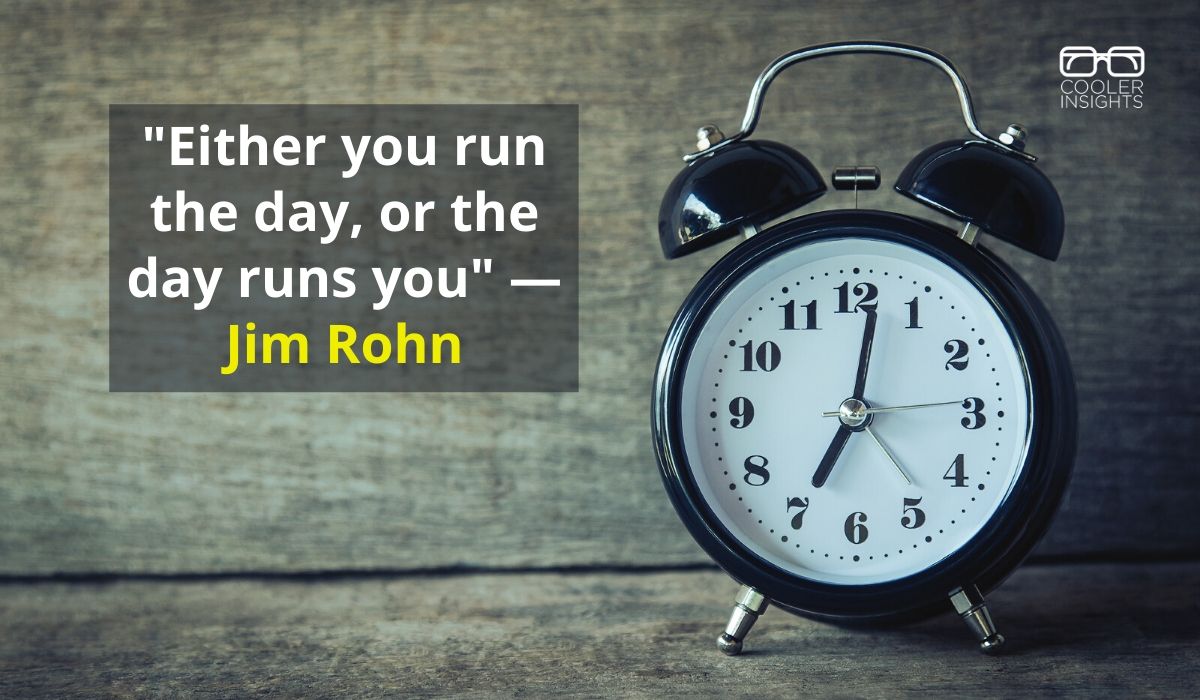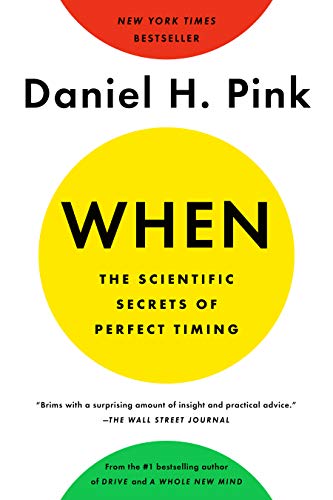
Time and tide waits for no man. A stitch in time saves nine.
These time-honoured aphorisms were often uttered by my dad – an impatient man who doesn’t enjoy waiting in queues.
My father (aka “Pop” as we call him) isn’t the only one who treasured time. Many of us do too. Especially in an “always-on” world where we’re constantly running out of time to do the things we need to do, and the things we love to do.
Thanks to the book When – The Scientific Secrets of Perfect Timing by renowned psychology author Daniel Pink, I managed to learn a few time hacks and productivity secrets that you could apply to optimize your days, weeks, months and years.
Ready for the time of your life? Let us begin with a day in our lives.
Daily Rhythms and Chronotypes
Are you a lark (morning bird), owl (night bird) or a third bird (somewhere in between)?
This reflects your levels of mental alertness and physical energy at different times of the day. It also determines the best time for you to do different types of tasks.
Also known as your biological rhythm (biorhythm) or circadian rhythm, these different peaks make a significant difference in the activities that you choose at different times of the day.
To find out, track your energy levels at different hours of the day – from 7 a.m. to 11.30 p.m. – and measure on a scale of 1 to 10 what your mental alertness and physical energy levels are like for each hour.
Here are the recommendations from Dan Pink for folks belonging to different chronotypes.
| Lark (Early Birds) | Third Bird | Owl (Night Bird) | |
| Analytic Tasks | Early morning | Early to midmorning | Late afternoon and evening |
| Insight Tasks (require creativity and intuition) | Late afternoon/ early evening | Late afternoon/ early evening | Morning |
| Making an Impression | Morning | Morning | Morning (yes, them too!) |
| Making a Decision | Early morning | Early to midmorning | Late afternoon and evening |
PS – the majority of us are third birds (60 to 80 percent), which means we function better in the midmorning.
Exercise Tips
To lose weight, try to exercise first thing in the morning BEFORE breakfast when your blood sugar is low – you may burn 20 percent more fat than later, post-food workouts. In fact, exercising in the mornings will also help to boost your moods and help you to keep to your routines!
Afternoon workouts are good if you want to push yourself harder, as your strength levels will peak then.
More Morning Hacks
Drink a glass of water when you get up to rehydrate.
Don’t drink coffee immediately after you wake up. Instead, wait an hour or so, after your cortisol levels have decreased. This will help the caffeine in your coffee to do its magic.
(And if you need to drink again in the afternoon? Between 2 pm to 4 pm is the best time, when cortisol levels dip again.)
Get some morning sun if you can too – the light signals to your brain to stop producing sleep hormones.
Break Your Afternoon Energy Dips
The majority of us experience a drop in productivity after lunch. Also known as the mid-day dip, it is also the period of time where more accidents happen!
To prevent this, take a restorative break (not necessarily with a KitKat) by following these best practices:
- Vigilance Break: Run through a checklist of items to sense where you’re currently at. Best if you can do it as a team.
- Move Your Body: Take a walk around the office, or house, or a park if you can. Natural vegetation has been shown to be highly rejuvenating.
- Look Out the Window: If you can’t get out of your workplace or classroom, at least allow your eyes to wander (yes daydreaming IS restorative!)
- Take a Caffeine Nap: Down a cup of coffee and then enjoy a short nap of 15 to 20 minutes max. This will allow the caffeine time to work on your system (about 25 minutes), and your energy levels to peak when you awake.
- Avoid Long Naps: Anything longer than 30 minutes may result in sleep inertia – this will mean that you’ll need more time to recover after your snooze before you can be productive.
Beginnings, Mid-points and Endings
Now that you’ve straightened up your days, the next thing you should consider is how you can manage the different stages of your work and your life.
How to Start (or Restart) Right
Everybody knows the importance of a good start. But what happens when your stumbled off the blocks at the start line?
Pink suggests that you should consider doing a pre-mortem to pre-empt possible dangers and challenges BEFORE they occur. So anticipate where the barriers and traps are ahead of time, and rehearse (in your mind) how you can avoid them.
Consider using anniversary dates to make a fresh start. There are 86 days (!!!) in the book, and they include occasions like…
- The first day of the month
- Mondays
- Your country’s National or Independence Day
- Your birthday
- The first day of a new year
- The anniversary of your wedding
- The day you read this article
Managing Your Midpoints
Just like the dreaded afternoons, midpoints can be muddling – ask anybody in their 40s to 50s (like me) how they feel, and their answer is likely to be less than inspiring.
According to Pink, there is a “U-curve of happiness – a mild slump of well-being” in midlife. This same phenomenon can also be seen in projects (people are more likely to cut corners in the middle).
To counteract this, consider the following strategies:
- Set interim goals and commit to them: Use these milestones to help you cross each mini milestone.
- Picture how your work can help others: Knowing that you are giving to the broader community helps you to find meaning in the middle.
- Find a mentor: Especially when you are in a midcareer phase in your work.
How to End on a High
Do you know that most of the people who sign up for marathons tend to do so at the end of a decade (ie when they’re 29, 39, 49, or 59)?
Or that we give the greatest weight to any event during its most intense moment (peak) and how it finishes (the end) – a phenomena known as the “peak-end” rule?
Endings can be codified with the four Es:
- Energize: We tend to give one last “kick” when we reach the finish line. This is why an impending deadline boosts productivity like nothing else!
- Encode: Endings have a disproportionate influence – hence if we’re gunning for a promotion, we should make sure that our performance close to appraisal period is sublime!
- Edit: When time is no longer on our side and we’re reaching the end of a phase – eg our lives, our worklife, or our school life – we tend to cut out what is non-essential.
- Elevate: We much prefer endings that are happy – or better yet poignant. Poignancy is a mix of happiness and sadness, a complex emotion which evokes deeper meaning and significance, like a “rush of unexpected insight, a fleeting moment of transcendence, the possibility that by discarding what we wanted we’ve gotten what we need.”
To create better endings, consider spending the final minutes of your work day writing down what you accomplished, reflecting on what you’ve not done, and laying out your plan for the next day. This will energize your tomorrows.
For companies, consider a way to end any customer purchases on a positive note. Like giving them a thank you card, or applauding them as they leave your store! You can also give them a free gift that they did not expect.
Synchronising as a Group
As social animals, we human beings enjoy the feeling of belonging to a specific tribe.
To ensure greater synchrony when you work in any group, consider the following strategies:
- Appoint a Leader: From symphonies to sports teams, the best groups have a boss who keeps the group in perfect timing. He or she sets the pace, maintain standards, and focus on the collective mind.
- Build Tribe Identity: Do this by incorporating unique codes (lingo for the tribe), garbs (what the tribe wears), and touch (a way to connect with each other).
- Harmonize Group Timing: Keep to a consistent beat and schedule to what you do – from the frequency of your social media posts, the regularity of your exercise regimes, to the timings for your office activities.
To promote belonging in any group, consider the following activities and best practices:
- Group Performances: From singing in a choir, dancing as a crew, to cooking in tandem – such group activities that require synchronizations can deliver a positive euphoric feeling.
- Improv Exercises: Do improv exercises such as trying to mirror each other (Simon says), continue a story (or rap) that a person starts, or passing the electricity from one person to another person.
- Struggle Stories: Sometimes telling such stories help to foster bonding and cohesion.
- Nurture Group Rituals: From fist bumps to chest thumps, rituals that developed organically by the group (not forced from top-down) can build group harmony.
Conclusion
What I’ve covered above are some of the main ideas from the book When – there are tonnes of great insights in the book which I strongly encourage you to get.
Personally, I have adopted some of the best practices to improve the productivity of my day. As a middle-aged man, I intend to overcome my “midpoint malaise” by setting interim goals, and perhaps finding ways to make my work meaningful to the world.
I’m sure that my dad would also approve of these ideas as he crossed his 81st birthday. I wonder how he’d view time though.
What about you? How would you change the way you time your life?
“Time isn’t the main thing. It’s the only thing.” – Miles Davis

